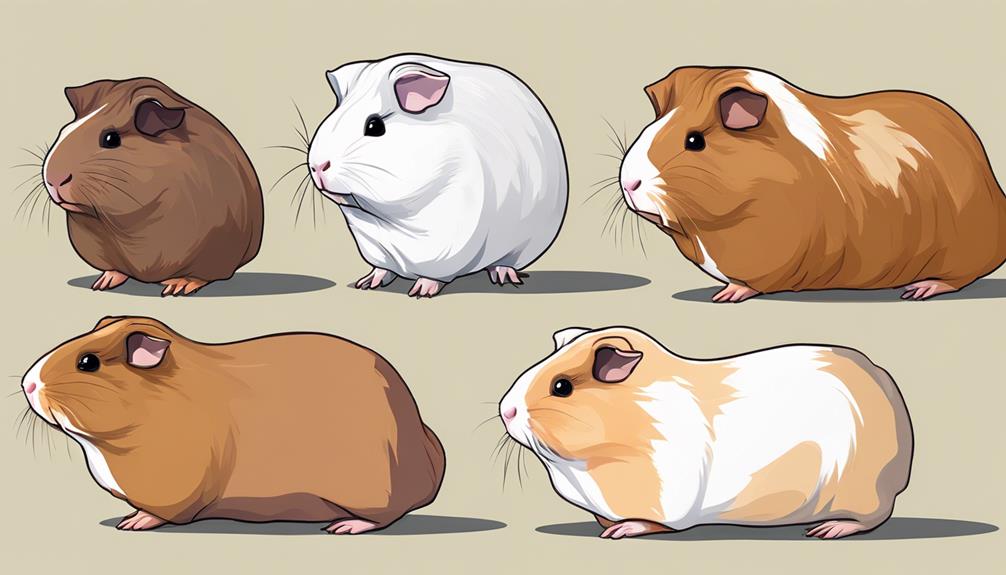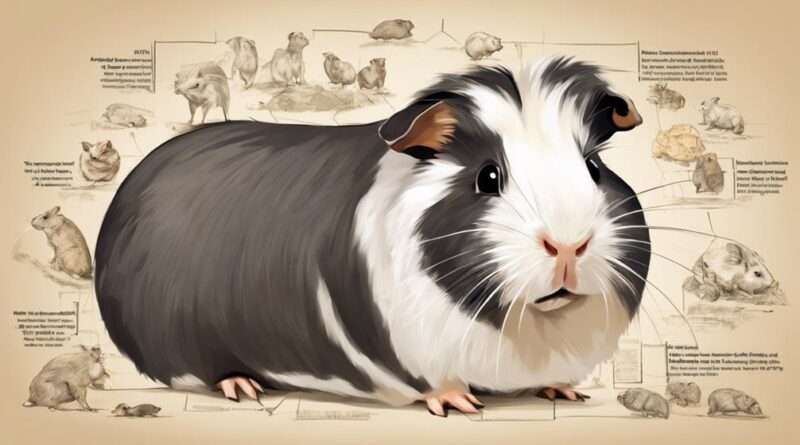Exploring the Historical Journey of Domesticated Guinea Pigs
As you ponder the humble beginnings of domesticated guinea pigs, you may be surprised by the intertwined paths they have taken throughout history. From their roles in ancient civilizations to their significance in European exploration, these small creatures have left a lasting impact.
But what about their contributions to scientific research, their popularity as pets, or their evolving breeds?
The journey of domesticated guinea pigs holds a treasure trove of fascinating stories waiting to be discovered.
Origins of Guinea Pig Domestication
The origins of guinea pig domestication trace back to ancient South America, where these furry creatures were first tamed by indigenous communities. These communities recognized the genetic diversity present in guinea pigs, leading to selective breeding practices that shaped the future of these animals. Through careful breeding, they developed guinea pigs with various coat colors and patterns, showcasing the early understanding of genetics among these ancient peoples.
Culturally, guinea pigs held significant importance in these societies beyond their practical uses. They weren't only a source of food but also played essential roles in ceremonial rituals and traditional medicine practices. The cultural significance of guinea pigs extended to their role as symbols of prosperity, fertility, and even sacrifice in certain ceremonies. These creatures were deeply woven into the fabric of daily life and belief systems, highlighting their integral role in the ancient South American cultures that domesticated them.
Ancient Cultures' Guinea Pig Utilization
Exploring the historical utilization of guinea pigs by ancient cultures reveals their multifaceted roles beyond mere companionship or sustenance. In various ancient civilizations, guinea pigs played significant roles in ritual sacrifices and were believed to possess healing properties.
Ancient cultures, such as the Inca civilization in South America, considered guinea pigs as sacred animals used in religious ceremonies and offerings. These small creatures were often sacrificed as part of rituals to honor gods or seek their favor. The Incas believed that guinea pigs had a special connection to the spiritual world, making them essential for communicating with deities.
Furthermore, guinea pigs were also valued for their perceived healing properties in ancient cultures. In traditional medicine practices, guinea pigs were used in various remedies and treatments. Their presence was believed to bring about physical and spiritual healing, making them integral to the well-being of individuals within these societies.
Guinea Pigs in European Exploration

During European exploration, guinea pigs became a valuable resource for sailors due to their ability to provide a portable source of fresh meat on long voyages. European colonization brought guinea pigs from South America to Europe, where they quickly gained popularity not only as a food source but also as pets among the elite.
As European ships set sail to explore the New World, they carried guinea pigs on board to serve as a sustainable source of protein. Their docile nature and ability to reproduce quickly made them an ideal food source that could be replenished easily during long sea voyages. This cultural exchange between South America and Europe facilitated by guinea pigs highlights how these small animals played a significant role in shaping the course of history.
Guinea pigs also became commodities in the trade between Europe and other continents, further spreading their presence around the world. The introduction of guinea pigs to Europe not only satisfied the culinary preferences of sailors but also sparked curiosity and interest in these exotic creatures. This exchange of goods and ideas through the medium of guinea pigs symbolizes the interconnectedness of different cultures during the age of exploration.
Guinea Pigs in Scientific Research
Guinea pigs' role in scientific research has been pivotal in advancing our understanding of various medical conditions and treatments. These small creatures have been instrumental in numerous scientific advancements and medical breakthroughs. Through ethical implications and animal testing, researchers have been able to test new drugs, study diseases, and develop treatments that have significantly improved human health.
Animal testing involving guinea pigs has played a crucial role in the development of vaccines for diseases like diphtheria and whooping cough. Their use in allergy research has also led to the understanding of how certain substances trigger allergic reactions in the body. Additionally, guinea pigs have been valuable in studying conditions such as diabetes, hearing loss, and digestive disorders.
While the use of animals in scientific research raises ethical concerns, guinea pigs have provided valuable insights that have saved countless lives. The knowledge gained from studies involving these animals has paved the way for the development of life-saving medications and treatments. By balancing the ethical implications with the need for scientific progress, researchers can continue to make important discoveries that benefit both human and animal health.
Guinea Pigs as Pets
When considering guinea pigs as pets, understanding their specific care requirements is essential for ensuring their well-being. Guinea pigs are popular pets known for their gentle nature and social behavior, making them great companions for both individuals and families. Apart from the joy they bring, owning guinea pigs can also offer various health benefits. The act of caring for these small creatures can reduce stress and promote a sense of responsibility and routine in your life.
To keep your guinea pig healthy, provide a balanced diet consisting of hay, fresh vegetables, fruits, and pellets rich in Vitamin C. Guinea pigs can't produce this essential vitamin on their own, so it's crucial to supplement it through their diet. Additionally, make sure they have a spacious cage with hiding spots, toys for mental stimulation, and a constant supply of fresh water. Regular veterinary check-ups are also vital to ensure they're in good health.
When it comes to training tips, guinea pigs can be taught to recognize their names and respond to simple commands using positive reinforcement techniques such as treats and praise. Be patient and consistent in your training efforts, and always respect your pet's boundaries. With proper care, attention, and love, guinea pigs can thrive as delightful and rewarding pets in your household.
Guinea Pigs in Modern Agriculture
Understanding the historical context of guinea pigs as household pets offers valuable insights into their role in modern agriculture practices. These adorable creatures have found a place in sustainable farming methods, promoting ethical consumption in the agricultural industry.
In sustainable farming, guinea pigs play a vital role in pest control and waste management. Their natural foraging behavior allows them to efficiently graze on weeds, reducing the need for herbicides. Additionally, guinea pigs produce nutrient-rich manure that can be used to fertilize crops, enhancing soil quality without relying on synthetic chemicals. This eco-friendly approach aligns with the principles of sustainable farming, which aim to minimize environmental impact and promote long-term agricultural sustainability.
Moreover, guinea pigs contribute to ethical consumption practices by serving as a source of protein in regions where traditional livestock farming may not be feasible. Their small size and low environmental footprint make them a practical and sustainable meat option for communities facing resource constraints. By incorporating guinea pigs into agricultural systems, farmers can diversify their sources of protein while prioritizing animal welfare and resource efficiency.
Guinea Pig Breeds Evolution

As you delve into the evolution of guinea pig breeds, you'll uncover a fascinating journey of genetic diversity and selective breeding.
- Genetic Diversity: Guinea pigs exhibit a wide range of coat colors, patterns, and fur textures due to their genetic diversity. From the sleek and shiny coats of the Abyssinian guinea pigs to the long, flowing locks of the Peruvian guinea pigs, each breed showcases a unique set of genetic traits that have been selectively bred over time.
- Selective Breeding: Over centuries, humans have carefully selected guinea pigs with desirable traits to propagate specific characteristics in different breeds. For example, the American guinea pig was selectively bred for its docile temperament and suitability as a pet, while the Skinny Pig was bred to be hairless for those with allergies to fur.
- Evolutionary Adaptations: Through selective breeding practices, guinea pigs have evolved to thrive in various environments and serve different purposes. Whether it's the robust Texel guinea pig known for its curly coat or the agile and athletic Coronet guinea pig, each breed has adapted to fulfill specific roles based on human preferences and needs.
This intricate dance between genetic diversity and selective breeding has shaped the diverse array of guinea pig breeds we see today, each with its own unique charm and characteristics.
Conservation Efforts for Guinea Pigs
In the realm of guinea pig conservation, efforts are being made to preserve and protect these beloved small animals. Conservation initiatives often involve breeding programs aimed at maintaining healthy populations and genetic diversity among guinea pigs. Captive breeding plays a crucial role in ensuring the survival of endangered guinea pig species and breeds.
One significant aspect of conservation efforts is habitat restoration. Guinea pigs are native to South America, where their natural habitats are increasingly threatened by deforestation and urbanization. Conservationists work to restore these habitats to provide guinea pigs with safe environments where they can thrive and reproduce naturally.
Captive breeding programs are essential for species facing extinction in the wild. By carefully selecting breeding pairs based on genetic diversity, conservationists can prevent inbreeding and maintain healthy populations. These programs also serve as a safety net, ensuring that if wild populations decline further, there will be a reserve of guinea pigs that can potentially be reintroduced into their natural habitats.
Frequently Asked Questions
How Did the Domestication of Guinea Pigs Impact the Natural Behavior and Characteristics of Wild Guinea Pig Populations?
When people domesticated guinea pigs, their behavior and characteristics changed. Genetic mutations occurred, influencing wild populations. Behavior changes can result from captivity.
Evolutionary adaptations may have been affected as well. Habitat destruction due to human activities also impacted wild guinea pigs. All these factors combined to alter the natural behavior and characteristics of wild guinea pig populations over time.
Are There Any Myths or Legends Surrounding Guinea Pigs in Ancient Cultures That Have Been Passed Down Through Generations?
In ancient cultures, mythical origins and cultural beliefs surrounded guinea pigs. Passed down through generations, these stories often depicted guinea pigs as sacred animals with special powers or connections to deities.
Some legends portrayed guinea pigs as symbols of prosperity or good luck, while others linked them to rituals or ceremonies. These diverse myths and legends reflect the significance of guinea pigs in various ancient societies and the rich tapestry of beliefs surrounding them.
How Have Advancements in Technology Influenced the Use of Guinea Pigs in Scientific Research Over the Years?
Advancements in technology have greatly impacted the use of guinea pigs in scientific research. Ethical implications have led to more refined research applications and the development of genetic modifications.
These technological advancements have improved data collection, analysis, and overall understanding of various diseases and treatments. Guinea pigs continue to play a crucial role in research, thanks to these advancements that ensure more precise and humane studies.
What Are Some Lesser-Known Guinea Pig Breeds That Have Played a Significant Role in Their Evolution as Pets?
When thinking about lesser-known guinea pig breeds that shaped them into beloved pets, consider the genetic diversity brought by breeding programs. Some breeds, like the Baldwin and the Ridgeback, played significant roles.
These breeds hold cultural significance, tied to folklore traditions in various regions. Exploring their evolution reveals the intricate ways in which human intervention and natural selection have influenced the guinea pig population.
How Do Conservation Efforts for Guinea Pigs Differ in Various Regions Around the World, and What Challenges Do Conservationists Face in Protecting These Species?
Conservation challenges around the globe vary for guinea pigs, posing unique obstacles for those striving to protect these species. Global efforts involve diverse strategies tailored to each region's needs. Conservationists face hurdles like habitat loss, climate change, and human interference.
Balancing these factors with sustainable conservation practices is critical for safeguarding guinea pig populations worldwide. Collaborative efforts and innovative solutions are essential in overcoming these challenges and ensuring a future for these beloved creatures.
Conclusion
You have learned about the fascinating historical journey of domesticated guinea pigs, from their origins in South America to their roles in ancient cultures, European exploration, scientific research, and modern agriculture.
These adorable pets have evolved through different breeds and continue to be cherished by many as companions.
Conservation efforts are underway to protect these unique animals and ensure their well-being for future generations.
Guinea pigs truly have a rich and diverse history worth exploring.
